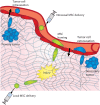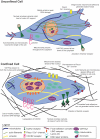Mechanosensing of Mechanical Confinement by Mesenchymal-Like Cells
- PMID: 32390868
- PMCID: PMC7193100
- DOI: 10.3389/fphys.2020.00365
Mechanosensing of Mechanical Confinement by Mesenchymal-Like Cells
Abstract
Mesenchymal stem cells (MSCs) and tumor cells have the unique capability to migrate out of their native environment and either home or metastasize, respectively, through extremely heterogeneous environments to a distant location. Once there, they can either aid in tissue regrowth or impart an immunomodulatory effect in the case of MSCs, or form secondary tumors in the case of tumor cells. During these journeys, cells experience physically confining forces that impinge on the cell body and the nucleus, ultimately causing a multitude of cellular changes. Most drastically, confining individual MSCs within hydrogels or confining monolayers of MSCs within agarose wells can sway MSC lineage commitment, while applying a confining compressive stress to metastatic tumor cells can increase their invasiveness. In this review, we seek to understand the signaling cascades that occur as cells sense confining forces and how that translates to behavioral changes, including elongated and multinucleated cell morphologies, novel migrational mechanisms, and altered gene expression, leading to a unique MSC secretome that could hold great promise for anti-inflammatory treatments. Through comparison of these altered behaviors, we aim to discern how MSCs alter their lineage selection, while tumor cells may become more aggressive and invasive. Synthesizing this information can be useful for employing MSCs for therapeutic approaches through systemic injections or tissue engineered grafts, and developing improved strategies for metastatic cancer therapies.
Keywords: cancer; confinement; differentiation; migration; stem cell.
Copyright © 2020 Doolin, Moriarty and Stroka.
Figures




Similar articles
-
Mechanobiology of mesenchymal stem cells: Perspective into mechanical induction of MSC fate.Acta Biomater. 2015 Jul;20:1-9. doi: 10.1016/j.actbio.2015.04.008. Epub 2015 Apr 11. Acta Biomater. 2015. PMID: 25871537 Review.
-
Integration of Mesenchymal Stem Cells into a Novel Micropillar Confinement Assay.Tissue Eng Part C Methods. 2019 Nov;25(11):662-676. doi: 10.1089/ten.TEC.2019.0083. Epub 2019 Sep 11. Tissue Eng Part C Methods. 2019. PMID: 31347455 Free PMC article.
-
The matrix environmental and cell mechanical properties regulate cell migration and contribute to the invasive phenotype of cancer cells.Rep Prog Phys. 2019 Jun;82(6):064602. doi: 10.1088/1361-6633/ab1628. Epub 2019 Apr 4. Rep Prog Phys. 2019. PMID: 30947151 Review.
-
Senescence induces fundamental changes in the secretome of mesenchymal stromal cells (MSCs): implications for the therapeutic use of MSCs and their derivates.Front Bioeng Biotechnol. 2023 May 9;11:1148761. doi: 10.3389/fbioe.2023.1148761. eCollection 2023. Front Bioeng Biotechnol. 2023. PMID: 37229499 Free PMC article. Review.
-
Nuclear Deformation in Response to Mechanical Confinement is Cell Type Dependent.Cells. 2019 May 8;8(5):427. doi: 10.3390/cells8050427. Cells. 2019. PMID: 31072066 Free PMC article.
Cited by
-
Microporous Annealed Particle (MAP) Scaffold Pore Size Influences Mesenchymal Stem Cell Metabolism and Proliferation Without Changing CD73, CD90, and CD105 Expression Over Two Weeks.Adv Biol (Weinh). 2024 Feb;8(2):e2300482. doi: 10.1002/adbi.202300482. Epub 2023 Nov 13. Adv Biol (Weinh). 2024. PMID: 37955859 Free PMC article.
-
Cell-Level Modelling of Homeostasis in Confined Epithelial Monolayers.J Elast. 2025;157(2):29. doi: 10.1007/s10659-025-10120-0. Epub 2025 Feb 24. J Elast. 2025. PMID: 40013236 Free PMC article.
-
Perfusion Bioreactor Culture Incorporating Mechanical Confinement Enhances Mesenchymal Stem Cell Extracellular Vesicle Production and Wound Healing Potential.bioRxiv [Preprint]. 2025 Aug 15:2025.08.12.669872. doi: 10.1101/2025.08.12.669872. bioRxiv. 2025. PMID: 40832244 Free PMC article. Preprint.
-
Coordinated in confined migration: crosstalk between the nucleus and ion channel-mediated mechanosensation.Trends Cell Biol. 2024 Oct;34(10):809-825. doi: 10.1016/j.tcb.2024.01.001. Epub 2024 Jan 29. Trends Cell Biol. 2024. PMID: 38290913 Review.
-
Spatial confinement alters morphology, spreading dynamics, and mechanics of adherent platelets.Biophys Rep (N Y). 2025 Jul 24;5(3):100222. doi: 10.1016/j.bpr.2025.100222. Online ahead of print. Biophys Rep (N Y). 2025. PMID: 40714404 Free PMC article.
References
Publication types
Grants and funding
LinkOut - more resources
Full Text Sources

